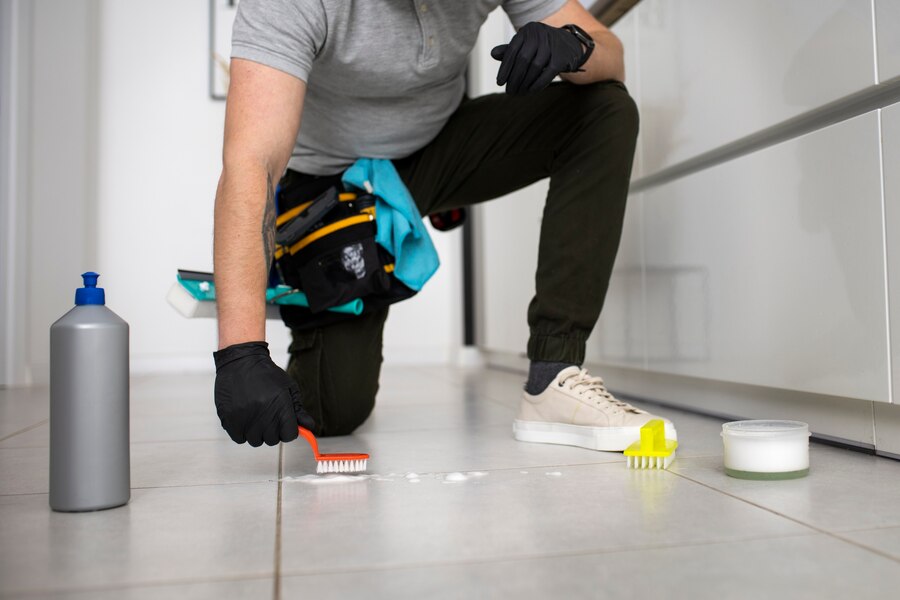
In home maintenance, few tasks are as simultaneously satisfying and challenging as grout cleaning. Whether tackling a small kitchen backsplash or a sprawling bathroom floor, understanding the secrets to effective grout cleaning can make a significant difference. Grout, a mixture of cement, water, and sand, binds tiles together while absorbing dirt, mold, and stains over time. This accumulation not only dulls the appearance of your tiles but can also harbor bacteria and allergens if left untreated.
The Ultimate Guide to Grout Cleaning Secrets delves into the nitty-gritty of rejuvenating your tiled surfaces, focusing on techniques beyond essential scrubbing. From natural DIY solutions to advanced cleaning products, we explore methods to restore grout to its pristine condition. Discover how to prevent discoloration, tackle stubborn mildew, and maintain the longevity of your tile installations. Whether you’re a first-time homeowner or a seasoned DIY enthusiast, mastering these grout cleaning secrets will ensure your spaces gleam with renewed brilliance.
Understanding Grout: Composition and Types
Grout, composed of cement, water, and sand, plays a vital role in tile installations by filling gaps between tiles for structural support and aesthetic enhancement. It comes in various types—cement-based, epoxy-based, and urethane-based—each suited to different durability and application requirements. Cement-based grout is versatile and cost-effective, making it ideal for most residential uses.
Epoxy-based grout offers superior stain resistance and is perfect for high-moisture areas and heavy traffic. Urethane-based grout combines flexibility with durability. Understanding these distinctions empowers homeowners to select the right grout type, ensuring their tiled surfaces remain durable and visually appealing over time.
Importance of Regular Grout Maintenance
Regular grout maintenance is crucial for preserving the beauty and functionality of tiled surfaces throughout your home. Porous grout readily absorbs dirt, grime, and moisture, which can lead to discoloration, mold growth, and even structural damage if left unchecked.
- Prevents Discoloration: Regular cleaning prevents grout from becoming discolored due to dirt and mold buildup.
- Avoids Mold Growth: Cleaning and sealing inhibit mold and mildew growth, maintaining a healthier indoor environment.
- Preserve Structural Integrity: Regular maintenance prevents grout deterioration, ensuring tiles remain securely in place.
- Enhances Longevity: Proper care extends the lifespan of grout, reducing the need for costly repairs or replacements.
- Maintains Aesthetic Appeal: Clean grout lines contribute to a visually appealing and well-maintained home interior.
Consistency is vital when it comes to grout maintenance. Establishing a schedule for cleaning and sealing grout lines, ideally every six months to a year helps maintain cleanliness and prevents irreversible damage.
Essential Tools and Supplies for Effective Cleaning
Effective grout cleaning requires the proper tools and supplies to achieve optimal results. The right equipment ensures that dirt, grime, and stains can be tackled without damaging your tiles.
- Stiff-bristled brush or grout brush: Ideal for scrubbing dirt and grime out of grout lines without scratching tiles.
- Handheld scrubbing tool or electric toothbrush: Provides additional scrubbing power for stubborn stains and hard-to-reach areas.
- Microfiber cloths or towels: Used for wiping down surfaces and drying grout lines after cleaning.
- Cleaning solutions: Choose from commercial grout cleaners for tough stains or natural DIY solutions like vinegar and baking soda for eco-friendly options.
- Grout sealer: Essential for protecting clean grout lines from future stains and moisture infiltration.
With these tools and supplies, you can confidently tackle grout-cleaning projects throughout your home. Remember to follow manufacturer instructions for cleaning solutions and sealers to ensure safe and effective use.
Natural DIY Solutions vs. Commercial Cleaners: Pros and Cons
Homeowners often choose between natural DIY solutions and commercial cleaners when tackling grout cleaning. DIY options like vinegar and baking soda are praised for their affordability, safety, and eco-friendliness. They effectively remove light stains without harsh chemicals.
However, they may necessitate more effort and multiple applications for stubborn stains. Conversely, commercial cleaners contain potent chemicals designed to combat tough stains, mold, and mildew more efficiently and with less labor.
These products are available in tailored formulations for different grout types, yet some may require ventilation and cautious handling due to their harsh nature. Ultimately, the decision hinges on personal preferences, cleaning objectives, and concerns regarding safety and environmental impact.
Step-by-Step Guide to Deep Cleaning Grout
Deep cleaning grout is essential for restoring the sparkle to your tiled surfaces and maintaining longevity. Follow these steps for a thorough grout cleaning session that will leave your tiles looking brand new:
- Prepare the Area: Ensure good ventilation and protect surrounding surfaces before starting.
- Apply Cleaning Solution: Use a suitable commercial or homemade cleaner and apply it directly to the grout lines.
- Let It Sit: Let the cleaner penetrate the grout for several minutes to loosen dirt and stains effectively.
- Scrub Vigorously: Use a stiff-bristled or grout brush to scrub the grout lines, focusing on stubborn areas.
- Rinse and Dry: Rinse the area with clean water and dry thoroughly to prevent mold growth.
Deep cleaning grout requires time and effort but pays off with beautifully clean tiles. By following these steps diligently, you can achieve professional-level results and extend the lifespan of your tiled surfaces.
Preventative Measures: How to Keep Grout Clean Longer
Regular preventative measures are crucial for maintaining clean grout over time. Seal grout lines every six months to a year to create a protective barrier against stains and moisture, especially in high-traffic areas like kitchens and bathrooms. Promptly clean up spills and stains to prevent them from penetrating the grout and causing discoloration.
Regularly sweep or vacuum tiled floors to remove abrasive dirt and debris that can wear down grout. Additionally, using mats or rugs in high-traffic areas can reduce the amount of dirt and moisture tracked onto tiled surfaces. These steps significantly extend the lifespan of grout and ensure cleaner, more attractive tiled spaces.
Dealing with Stubborn Stains and Discoloration
Stubborn stains and discoloration in grout lines can be challenging, even with regular cleaning. For mold and mildew stains, a mixture of hydrogen peroxide and baking soda applied directly to affected areas can effectively lift and brighten grout lines. Oxygen bleach products designed for grout cleaning offer a powerful alternative to chlorine bleach, effectively tackling tough stains without harsh chemicals.
Acidic cleaners like vinegar or lemon juice effectively break down deposits and restore grout to its original color to address mineral deposits and hard water stains. In severe cases, professional grout cleaning services may be necessary to deep clean and restore heavily stained grout. Regular maintenance and timely treatment of stains are crucial in preventing them from becoming deeply embedded, ensuring grout maintains its appearance and durability over time.
Green Cleaning: Eco-Friendly Alternatives
For eco-conscious homeowners, green cleaning methods like vinegar, baking soda, and lemon juice provide safe and versatile alternatives to traditional cleaners. These natural ingredients can be combined to create effective grout cleaners that lift dirt and stains without releasing harmful chemicals into the air or water systems. Steam cleaning with water alone offers another chemical-free option to sanitize grout lines and eliminate dirt and grime effectively.
Biodegradable and plant-based commercial cleaners also offer strong cleaning power while minimizing environmental impact. Opting for green cleaning methods helps maintain clean grout and tiled surfaces and reduces your carbon footprint, contributing to a healthier indoor environment for your family.
Techniques for Cleaning Different Types of Tile Grout
Understanding the specific needs of each type of tile grout is essential for maintaining their appearance and durability. The most common variety, cement-based grout, requires gentle cleaning to avoid damaging its porous surface.
- Cement-Based Grout: Clean with mild detergent and water, avoiding abrasive cleaners.
- Epoxy-Based Grout: Use pH-neutral cleaners to preserve durability and avoid abrasive products.
- Urethane-Based Grout: Clean with mild cleaners to maintain flexibility and resist cracking.
- Avoid Abrasive Cleaners: Prevent damage to grout surfaces by choosing gentle cleaning solutions.
- Regular Maintenance: Implement routine cleaning to prolong grout lifespan and appearance.
Mastering these techniques ensures that your grout remains clean and attractive, enhancing your tiled surfaces’ overall look and longevity. Choosing the proper cleaning methods and products tailored to your grout type can maintain a cleaner and more inviting home environment.
Finishing Touches: Sealing and Enhancing Grout Appearance
After cleaning grout lines, sealing is crucial to prevent future stains and discoloration. Please apply a suitable high-quality grout sealer evenly using a small brush or roller, ensuring thorough coverage along grout lines. Follow manufacturer instructions for drying times; multiple coats may be necessary, especially in high-traffic or moisture-prone areas.
Sealed grout becomes easier to maintain and effectively resists spills and stains. For a richer look, consider a color-enhancing sealer that deepens grout’s natural color, enhancing its vibrancy and uniformity across tiled surfaces. Regularly reapply the sealer as part of your maintenance routine to maintain long-lasting protection and aesthetic appeal.
Mastering the art of grout cleaning is not just about aesthetics; it’s about ensuring the longevity and cleanliness of your tiled surfaces. You can keep your grout lines looking fresh and pristine by understanding the composition and types of grout, implementing regular maintenance routines, and using the right tools and cleaning solutions.
Whether you opt for natural DIY cleaners or commercial solutions, each method has advantages depending on your preferences and environmental considerations. Remember to address stubborn stains promptly and apply preventative measures like regular sealing to protect your grout from future damage.
For those looking to save time or achieve professional results, consider contacting Harris Cleaning Services at 910-333-3231. Their expertise in grout cleaning and maintenance can help you restore and maintain the beauty of your tiled spaces efficiently and effectively.
Don’t wait until grime and stains take over – take proactive steps today to enjoy cleaner, healthier, and more appealing tiled surfaces tomorrow. Invest in your home’s cleanliness and longevity with the proper grout cleaning techniques and professional assistance. Your floors and walls will thank you with lasting durability and vibrant beauty.

